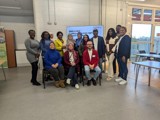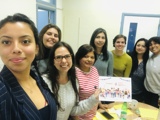As part of our London Communities Human Rights Programme, we worked with the Indoamerican Refugee & Migrant Organisation to support them to use the language of human rights law in their advocacy. IRMO staff members used the Human Rights Act, specifically the right to education under Article 2, Protocol 1, to challenge the inclusion of questions about immigration status on school enrolment forms. State schools must admit children regardless of their nationality or immigration status, yet local schools were including questions about this in admissions. The confidence to identify the human rights issues here and confidently use the Human Rights Act to challenge local policies, resulted in two local authorities changing their practice.
Human Rights Act Advocacy: Moving on from the mistakes and building the knowledge, capacity, and solidarity needed
Sanchita Hosali, CEO
And there is it, government rhetoric on the right to family life - Article 8 in our Human Rights Act (HRA) and the European Convention on Human Rights (ECHR) – has, this week, deteriorated into the all too predictable, and lazy, scapegoat for being seen to be “tough on immigration”. The optimism some may have felt last year, with a change in government after more than a decade of austerity and human rights erosion, is well and truly wearing off.
I’ve been in this space for more than 20 years. In that time, I’ve seen the HRA attacked, ignored, misunderstood. And often, inadequately championed. Sadly, we’re often loudest when we’re on the backfoot, in defensive mode against those seeking to weaken or remove the HRA. There has, of course, been some brilliant and vital rallying across civil society when the threat arrives. But it’s meant doing the tactical work to build the messages and stories whilst at the same time trying to fill the strategic confidence gap that enables speaking up when everything is at risk. All quite different to an approach grounded in standing in the power of human rights law as a key tool that works for people as “business as usual”. By my count we’ve had three serious attempts to scrap our human rights laws, troughs certainly, I’m not sure about the peaks. But the troughs are getting deeper and more ingrained. As we descend into yet another challenging period, it’s clear that we need to make some significant changes if we are to once again rally to crawl back up.
At BIHR we’ve invested in reflection and learning these past six months, and five key lessons stand out. Bear with me, it’s a little longer than I’d like, but given there is a lot at stake here, I hope it’s forgivable …
1. The blunt bit: some sector reflection
2. The buts: we need to say the words and do the doing
3. The difference: strategic implementation
4. The learning: driving change
5. The timing: it matters now
1. The blunt bit: some sector reflection
To be blunt, our collective approach to defending the HRA hasn’t always been strategic, sustainable or, indeed, successful. We are too often reactive rather than proactive. We’ve focused on what we’re against - scrapping or weakening - but not enough on what we’re for; the HRA as a living, working, practical framework. Resourcing in the face of risk often seems a far easier ask than averting the risk in the first place; from funders, donors, and an overstretched civil society.
But when we get to the doing, and not just being pushed to defending, the law can and does protect people’s dignity, equality, and autonomy. It can deliver meaningful everyday justice, often without going anywhere near a courtroom.
We’ve seen a huge focus on strategic litigation and communications as the key to delivering cut through, to change the narrative and the direction of travel, which has only got worse for universal human rights protections. It’s necessary work. We need the legal cases that demonstrate the reach of human rights protections in our lives, that provide hard-edged legal accountability when those with public power go too far. And we need communications that connect with people in a way that court cases simply do not for many of us. Communications that build positive associations, that tap into what people care about and what we can do.
2. The buts: we need to say the words and do the doing
But that’s a lot of heavy lifting for litigation and communication; and there are some buts …
There has been a tendency to move away from the words “human rights”. Even more so from boldly saying the words “Human Rights Act”, often with an emphasis on values as a proxy. As communications researchers consistently flag – backed by decades of experience we bring of working directly with thousands of people - there is a lot of commonality to be found across values like equality, fairness, dignity, respect. These are familiar words to us all, including to some of the most ardent critics of human rights.
That said, what working with people in their everyday life, beyond testing environments, also tells us is that what these values mean can be vastly different and often in conflict. What then? How do we navigate those very real tensions and get to a place where we agree not just on the fact that the values are important but on what they actually mean and what we can do with them? How do we connect these theoretical ideals to practical legal protections and make the case for why those legal protections matter?”
3. The difference: strategic implementation
This is where the strategic lessons from this practical implementation of the HRA gives us something vital: a legal framework that grounds values in universal standards with matching duties. These can be powerful tools for people to enable disruption and change. Action which shines a light on the particular marginalisation that different communities face, providing redress, within an approach that moves beyond concentric (and often justified!) self-interest and links us in shared common cause. Solidarity. The value of recognition and the pursuit of remedy and justice, not as additional or separate, but part of what universalism means.
Without longer-term, on the ground implementation that people can do, see, and feel, our human rights risk being abstract niceties, only for some people or in some situations. Or, as in the cycle we’ve now repeated at least 3 times in the last 15 years in the UK, only relevant or prioritizable when they’re already under threat.
We need to be clear that our human rights framework is not just something to be saved from repeal. It is an enabler, already working quietly, consistently, patiently. In hospitals, care homes, schools, housing services and individual and systems levels- communities are using the HRA to change lives.
But, of course, that needs to be true; the work does need to be done. We cannot simply tell stories of potential or what we’d like to see to sell human rights. We must do the doing. We must invest in the work that makes this real and amplify these stories of transformation already underway - real, relatable and relevant to people’s lives. The “implementation gap” in policy and campaigns work is increasingly being recognised. Not just in human rights but across the board there is tendency to forget that the big picture asks are not the end, but the means to it, the start of the change work.
Whilst the direct threat of scrapping our Human Rights Act may be off the table for the moment, this week we’ve moved from rumours of government reviews of some rights through to suspension of family life rights for some groups . And we cannot ignore how quickly the rumblings of re-looking at the European Convention and Court of Human Rights have emerged, barely one year in, predictably driven by the need to be seen to be “doing something” about immigration.
We cannot continue to make the same mistakes of previous years. At BIHR, we’re preparing for our new Strategy, with a focus on scaling up strategic implementation of the Human Rights Act with communities, public bodies and law- and policymakers.
4. The learning: driving change
We have done a lot of learning over the last five years, which has really focused on community HRA advocacy, alongside skilling up human rights duty-holders across public services, and injecting human rights analysis into national policy and law-making (plus, of course, defeating the boldest governmental attempt to date to scrap the Human Rights Act in Parliament).
In 2026 we’ll be sharing our next five-year Strategy. Here’s what we want to do differently – and we need the support to make it happen:
Ø Build a national network of human rights advocacy leads, drawn from our direct work with communities and organisations across the UK, supported to use the HRA in their dealings with the “state” across the everyday areas of housing, welfare, care, education, and health, focusing our efforts on building the knowledge and solidarity needed to effect change.
Ø Investing in community power, in real sustained human rights capacity and leadership, not simply one-off training or awareness raising (though these have their place too as part of an overall picture, they should not be sidelined or minimised, this is often the first vital step).
Ø Connecting the grassroots to national change so the realities of human rights on the ground and what our legal protections are directly influence how we shape national law and policy. This means moving beyond reactive fixes and after the fact remedies, towards building better rights-based law, policy and systems from the start.
Ø Creating the infrastructure to respond to political volatility while building long-term resilience, and common cause.
5. The timing: it matters now
Because the next five years will be critical. This work will take us through the next general election and beyond. No matter what the political outcome is, communities will need to be ready.
Ready to withstand further attacks on universal human rights.
Ready to influence the law-making process itself as a means of upholding human rights.
Ready to show that human rights aren’t abstract ideals — they’re the stuff of daily life, daily decisions, daily dignity and justice.
This is about moving from the defensive to proactive, positive change. From siloes to solidarity. From light-touch values to grounded, lawful, rights-based change. If you care about equality, justice, and social change, then you care about human rights even if right now that isn’t the language you use. We need to make saying it in those words and taking action the default.
We’re looking for funders, partners and collaborators who are ready to do this differently. We want to stop waiting for the next attack and start building the next chapter.
Email us on info@bihr.org.uk to chat about:
- Donations, regular giving, legacies and community fundraising.
- Funding a project or our essential core costs.
- Commissioning BIHR’s training, a programme or an event talk.
- Partnerships for funded work or to submit joint applications for funding.
- Supporting a policy project or commissioning our practical human rights research & analysis.
Stay up-to-date
Get our newsletter
Get monthly updates on UK human rights law and our work, resources and events sent straight to your inbox.









About the author
Sanchita
CEO